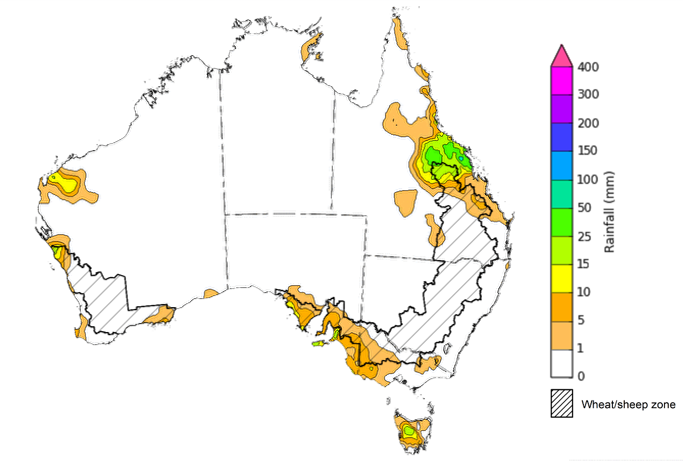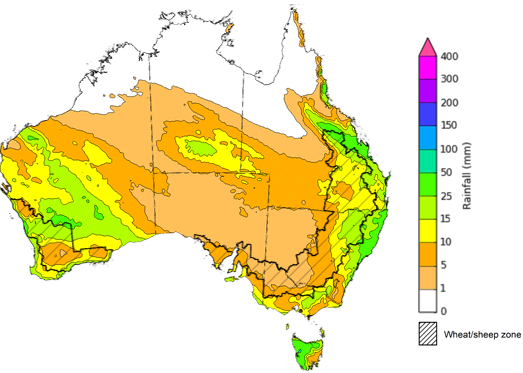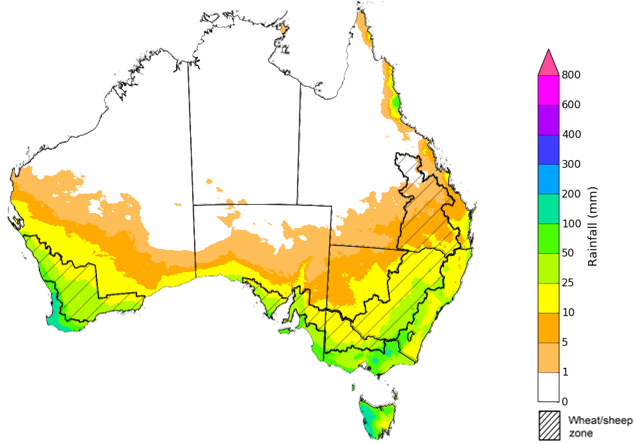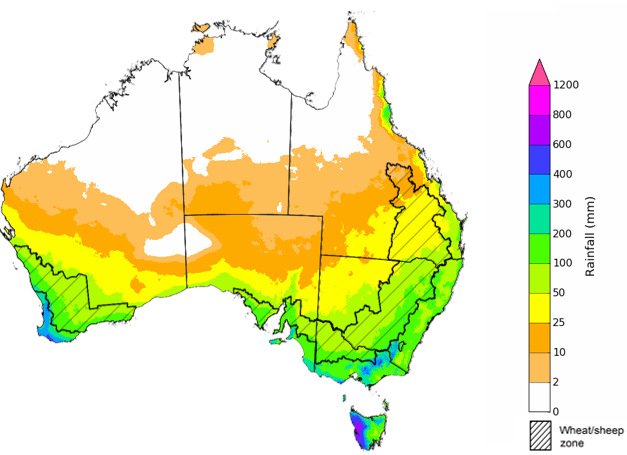Key issues
- In the week ending 29 May 2024, a high-pressure system kept much of Australia dry. Exceptions were southwest parts of Western Australia and Tasmania receiving up to 100 millimetres from cold front and northeast Queensland receiving up to 50 millimetres of rainfall from a low-pressure system.
- Across cropping regions, rainfall was limited, with falls of between 5 and 25 millimetres in scattered areas of Western Australia and northern Queensland. Meanwhile, falls of between 10 and 15 millimetres were recorded in South Australian and western Victoria. Remaining areas recorded little to no rainfall. Where received, this rainfall is expected to support the establishment and growth of winter crops.
- Over coming days, rainfall is forecast for much of southern two-thirds of Australia, associated with a low-pressure system and cold fronts to the west and south, and onshore flow from high-pressure system to the east.
- Across cropping regions, rainfall is expected across all states with totals of between 5 and 25 millimetres forecast for much of New South Wales, Queensland and Western Australia. Meanwhile, lighter falls of between 1 and 10 millimetres are forecast for cropping regions in southern New South Wales, Victoria and South Australia
- If realised, this forecast is expected to support the winter crop development across most growing regions.
- The national rainfall outlook for July to September is for above median rainfall more likely across interior areas of the country and scattered areas of coastal New South Wales.
- Across most cropping regions, the probability of exceeding median rainfall is between 45% and 70%. However, parts of northern Western Australia are showing an increased likelihood of experiencing below median rainfall. The outlook shows at least a 75% chance of receiving between 50 and 200 millimetres of rainfall across much of New South Wales, Victoria, South Australia and Western Australia. In Queensland, falls of between 25 and 100 millimetres are expected, with drier conditions forecast for far north.
- If realised, these expected rainfall totals will likely be sufficient to support growth and establishment of winter crops. Expected rainfall is also expected to boost soil moisture profile and assist in maintaining above average forecast winter crops yields.
- Water storage levels in the Murray-Darling Basin (MDB) increased between 20 June 2024 and 27 June 2024 by 76 gigalitres (GL). Current volume of water held in storage is 17 299 GL, equivalent to 78% of total storage capacity. This is 15 percent or 3,506 GL less than at the same time last year. Water storage data is sourced from the BOM.
- Allocation prices in the Victorian Murray below the Barmah Choke increased from $29 on 20 June 2024 to $43 on 27 June 2024. Prices are lower in the Murrumbidgee due to the binding of the Murrumbidgee export limit.
Climate
For the week ending 26 June 2024, a high-pressure system kept the majority of the country largely dry. Isolated areas of rainfall were recorded across parts of west, south and northeast Australia. A front brought rainfall totals of up to 25 millimetres on the South Australian coast and Tasmania, and up to 15 millimetres in isolated areas of Victoria. A series of low-pressure trough brought up to 50 millimetres of rainfall to north-eastern Queensland, while a trough brought isolated showers of up to 25 millimetres in Western Australia.
Across cropping regions, rainfall was limited, with falls of between 5 and 25 millimetres in scattered areas of Western Australia and northern Queensland. Meanwhile, falls of between 10 and 15 millimetres were recorded in South Australian and western Victoria. Remaining areas recorded little to no rainfall.
Rainfall for the week ending 26 June 2024

Issued: 26/06/2024
Note: The rainfall analyses and associated maps utilise data contained in the Bureau of Meteorology climate database, the Australian Data Archive for Meteorology (ADAM). The analyses are initially produced automatically from real-time data with limited quality control. They are intended to provide a general overview of rainfall across Australia as quickly as possible after the observations are received. For further information go to http://www.bom.gov.au/climate/rainfall/
Over the 8 days to 4 July 2024, rainfall is forecast for much of southern two-thirds of Australia, associated with low pressure system and cold fronts to the west and south, and onshore flow from high-pressure system to the east.
Across cropping regions, rainfall is expected across all states with totals of between 5 and 25 millimetres forecast for much of New South Wales, Queensland and Western Australia. Meanwhile, lighter falls of between 1 and 10 millimetres are forecast for cropping regions in southern New South Wales, Victoria and South Australia. If realised, this forecast is expected to support the winter crop development across most growing regions.
Total forecast rainfall for the period 27 June to 4 July 2024

Issued 27/06/2024
Note: This rainfall forecast is produced from computer models. As the model outputs are not altered by weather forecasters, it is important to check local forecasts and warnings issued by the Bureau of Meteorology.
The most recent rainfall outlook for July 2024 provided by the Bureau of Meteorology indicates an increased likelihood of above median rainfall across parts of western, central and coastal eastern Australia. There is an increased likelihood of below median rainfall across parts of southern Victoria, as well as parts of South Australia and Western Australia, as well as Tasmania and northern Australia.
According to Bureau of Meteorology’s climate model, for July 2024 there is a 75% probability of rainfall totals between 10 and 100 millimetres across much of central and eastern New South Wales, Victoria, southern South Australia, the southwest of Western Australia, and Tasmania. Alpine areas in Victoria, the far west Western Australia and Tasmania will likely receive rainfall of up to 200 millimetres. The north of the country is expected to remain largely dry, typical of this time of year, with exceptions in parts of the tropical northeast Queensland where up to 100 millimetres of rainfall is expected.
Across cropping regions, there is a 75% chance of receiving between 10 and 50 millimetres of rainfall in New South Wales, Victoria, South Australia and Western Australia. In Queensland, rainfall totals of between 5 and 25 millimetres are expected across southern growing regions, while little to no rainfall is forecast for northern growing regions. If realised, this rainfall is likely to be sufficient to support growth of winter crops across most cropping regions. Meanwhile, for Queensland cropping areas, crop growth is expected to be supported by a drawdown of stored soil moisture.
Rainfall totals that have a 75% chance of occurring in July 2024

Issued: 27/06/2024
For further information, go to http://www.bom.gov.au/climate/ahead/about/
The El Niño Southern Oscillation (ENSO) and Indian Ocean Dipole (IOD) climate drivers are currently neutral and having minimal influence on Australian rainfall.
The rainfall outlook for July through September 2024 indicates that above median rainfall is more likely across interior areas of the country and scattered areas of coastal New South Wales. Conversely, parts northern and southern Australia are expected to receive below median rainfall, with the probability of receiving median rainfall falling below 40% in isolated areas of parts of southern South Australia, Victoria, southwest Westen Australia, and across the northern tropic and Tasmania.
Across cropping regions, the probability of exceeding median rainfall is between 45% and 70% in across most growing regions. However, isolated northern parts of Western Australia’s cropping zone are showing an increased likelihood of experiencing below median rainfall.
Chance of exceeding the median rainfall July to September 2024

Issued: 27/06/2024
The outlook for July through September 2024 suggests a 75% chance of rainfall totals of between 25 to 200 millimetres likely across southern parts of the country, with heavier falls of up to 600 millimetres forecast for isolated areas of far southwest Western Australia, alpine regions of Victoria and New South Wales, and western Tasmania. In Queensland, falls of between 25 and 100 millimetres are expected in the southeast and parts of the northeast. Much of the remainder of the country is expected to receive little to no rainfall, consistent with these regions entering their dry season.
In cropping regions, there is at least a 75% chance of receiving between 50 and 200 millimetres of rainfall across much of New South Wales, Victoria, South Australia and Western Australia. In Queensland, falls of between 25 and 100 millimetres are expected, with drier conditions forecast for far northern cropping regions.
Expected rainfall is likely to be sufficient to support growth of winter crops and also expected to boost soil moisture profile and assist in maintaining above average forecast winter crops yields.
Livestock producers, especially those in the south, are expected to experience close to average pasture production on the back of the improving rainfall outlook over the July to September period.
Rainfall totals that have a 75% chance of occurring July to September 2024

Issued: 27/06/2024
Water
Water storages, water markets and water allocations - current week
The Tableau dashboard may not meet accessibility requirements. For information about the contents of these dashboards contact ABARES.
Commodities
Information on weekly price changes in agricultural commodities is now available at the Weekly commodity price update.
